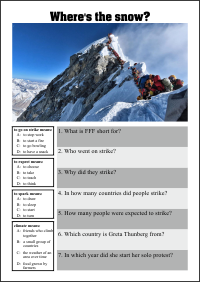
All of us have to learn how to invent our lives, make them up, imagine them. We need to be taught these skills; we need guides to show us how. If we don't, our lives get made up for us by other people.
Ursla Le Guin (1929-2018)
The Wave in the Mind, 2004
Fridays for Future
 Fridays for Future is the name for the school strike movement coming soon to a city near you (if it has not already). It is a brilliant example of the kind of direct action required to force change.
Fridays for Future is the name for the school strike movement coming soon to a city near you (if it has not already). It is a brilliant example of the kind of direct action required to force change.
For convenience there are two packs Each contains two different versions of the video and a PDF with transcripts and wordlists along with a question sheet. This features the now iconic image of climbers queuing to reach the top of Everest. The parallel between the Everest traffic jam and the demonstrations to save the planet are hard to ignore. Vanity meet the valiant! But what is perhaps more striking is the lack of snow at the roof of the world. This is the first image of Everest I've seen with the rock surface so exposed.
The video here is the full version of the report but all the videos in the pack omit the first interviewee. I find her just too fast to be coherent, though her point about declaring a climate emergency is an important one.
Transcript:
School students are holding strikes in countries around the world today to demand action on climate change. Organisers have said that more than a million people are expected to join in at least 110 countries. The strikes were sparked by the Swedish student Greta Thunberg whose solo protest outside Sweden's parliament last year has, led to movements across the world known as Fridays For Future.
From marches through the streets of Spain to demonstrations in India and protests in New Zealand, around the world the school strike movement continues to grow calling for urgent action on climate change.
"It is fundamental for me to be here. It is fundamental that everyone takes part in the strikes on the 24th of May as well as the strikes every single week. We are putting pressure on the governments and we want them to act fast and now."
Leading the protests in Sweden, 16 year old Greta Thunberg. Her decision to boycott classes in 2018 has prompted young people from around the world to follow suit.
" Some adults think it is wrong for us to go on strike instead of going to school. That we, instead, should study so that we can make a difference in the future. But the fact that it will be too late when we are finished with our studies is something they ignore."
And the organisers say today's global strike is their biggest yet. It comes as global temperatures are rising. The last four years have been the warmest on record and the U.N. says major changes are now needed...
Shorter version ends here
...That will mean cutting greenhouse gas emissions to zero by 2050 and ending our dependence on fossil fuels.
The students say it's their future that's at stake and are now calling for older generations to join their protests later this year. But while they are highlighting this global issue it's not yet clear if it will prompt the action from governments they demand.
The Pack
There are four videos all edited to skip references to the BBC correspondent. Two videos skip the details at the end. They cut out some tricky vocabulary and what is essentially a BBC inaccuracy. The deadline of 2050 is way too late to be of help - as the banner displayed behind the news anchor reads, "The dinosaurs thought they had time too..."
For both versions of the report there is a second video with keywords appearing as they are spoken. How to use the videos depends upon individual classes. For Junior High school students and younger I use the shorter videos.
Procedure:
1. Write up the letters F f F on the board. Invite the students to come up with meanings (Finland friendly forests was one answer I received). Lead the students to find the answer Fridays for Future
2. Ask students to talk about what they did the previous Friday. Students can either report to the class directly or use a Pair - Share - Share approach: students get into pairs, exchange information, make new pairs and relate their partners' experiences (cf. a six-step interview, Kagan: Cooperative Learning,1992 page 12:4).
3. Hand out the question sheet and talk about the Everest picture. Can students see beyond the long line of climbers and notice the lack of snow... (should be straightforward if they are used to reading titles).
4. Go through the multiple choice questions but don't confirm correct answers unless everyone is sure.
5. Show the video of your choice and pause it at the first break after the anchor finishes his opening remarks. Students can then use a write - pair - share approach: spend a couple of minutes answering the questions alone, then get into pairs to go over their answers and then go through the sheet together. If the group can't answer all the questions it is time to go through the video again or perhaps if the group started with the basic video watch the one with keywords to find or confirm answers.
6. With the question sheet dealt with it's time to focus on the second half of the video. There are various ways to do this - just make sure to print out the transcript that matches your choice on the back of the question sheet:
Group shout: The teacher reads through the transcript and pauses at various points (perhaps just before keywords). The group shouts out what comes next. This can also be done/repeated in pairs or groups.
Voiceover: Play the video with the sound muted. Students try and read the transcript and keep pace with the video. They can take turns doing this in pairs/groups paragraph by paragraph, sentence by sentence or do the whole transcript (tough!). Alternatively they can change roles every time the teacher pauses the video. Voiceover can also be done in groups or as a whole class exercise.
Spotters: Students work in pairs. One partner sits so they cannot see the video. A keyword video is played on mute. As the words appear the spotter calls them out and the partner jots down what they can on a piece of scrap paper. Roles are reversed and the process repeated. Students then try to fill out the transcript with gaps before watching a video once more with the sound up. The final showing can be with or without words and, of course, can be shown more than once. The aim is to complete the transcript. The whole process can also be done in groups but every student should have a chance to be a spotter at least once.
Watch and Work: Students watch a video and use a transcript to complete a task alone. The task could be to highlight/circle keywords or to fill out the gaps in a matching transcript. After every viewing students should share their work with a partner or group. Repeat viewings until the task is done.
My Take: watch the video and then students share their thoughts in pairs and then again in groups.
Quiz time: Students watch the video and then try and answer quiz questions supplied by the teacher. Questions can be asked randomly, perhaps by putting them on strips of paper or using a dice to roll and select a question from a list, The students aim to beat the quiz to 10 points. Play in rounds asking five questions at a time. The students get one point for every correct answer and the quiz gets one point for every answer missed. Don't give correct answers for missed questions but rather return them to the question supply so students can get another chance to watch the video and answer the question if it comes up again. Here is a list of possible questions in no particular order. Note the last five questions relate to the longer video only.
| No. | Questions (Click Boxes for Answers) | |
|---|---|---|
| 1. | Who thought they had time? | |
| The dinosaurs | ||
| 2. | How many people joined Greta Thunberg's first protest? | |
| None | ||
| 3. | How old is Greta Thunberg? | |
| 16 | ||
| 4. | What does the U.N. say is needed? | |
| Major changes (to our lifestyle) | ||
| 5. | How many countries does the report name with labels? | |
| 5 | ||
| 6. | In which country do we first see people protest? | |
| Spain | ||
| 7. | In which Spanish city do we see students protesting? | |
| Madrid | ||
| 8. | In which country is the second protest we see taking place? | |
| India | ||
| 9. | In which city in India do we see students protesting? | |
| Gurugram | ||
| 10. | The third protest we see takes place in which country? | |
| 11. | Where in New Zealand do we see students protesting? | |
| In Dunedin | ||
| 12. | Where in Germany do we see students protesting?? | |
| Cologne/ | ||
| 13. | We hear a boy speak. What is the colour of the flag he is holding? | |
| Green | ||
| 14. | What does a protest sign say is the new black? | |
| Green | ||
| 15. | What is the name of the protest movement? | |
| Fridays for Future | ||
| 16. | Name four of the five countries labelled in the report | |
| Spain, India, New Zealand, Germany, New Zealand | ||
| 17. | What is Greta Thunberg's nationality? | |
| Swedish | ||
| 18. | Who went on strike and why? | |
| Student to protest against climate change | ||
| 19. | In which city do we see Greta Thunberg speak? | |
| Stockholm | ||
| 20. | What are the colours of Greta Thunberg's clothes in the cartoon banner? | |
| Yellow (coat) and black (T-shirt) | ||
| 21. | Who thinks the students should study rather than strike? | |
| Some adults | ||
| 22. | What word beginning with "f" does one student protester use? | |
| Fundamental | ||
| 23. | Spell fundamental | |
| F-U-N-D-A-M-E-N-T-A-L | ||
| 24. | Who came up with the phrase Fridays for Future? | |
| Greta Thunberg | ||
| 25. | How many people did organisers think would strike? | |
| At least a million | ||
| 26. | How many countries saw strikes? | |
| 110 or more | ||
| 27. | Where did Greta Thunberg first protest? | |
| Outside the Swedish parliament | ||
| 28. | Which organisation made the world temperature map? | |
| NASA | ||
| 29. | What is rising? | |
| Global temperatures are | ||
| 30. | Spell temperature | |
| T-E-M-P-E-R-A-T-U-R-E | ||
| 31. | How should governments "act"? | |
| Fast and now | ||
| 32. | What word beginning with "u" describes the action needed for climate change? | |
| Urgent | ||
| 33. | What was the date of the protests? | |
| May 24th | ||
| 34. | What is the warmest on record? | |
| The last four years | ||
| 35. | On what day are protests happening every week? | |
| Friday | ||
| 36. | What two things need to be cut to zero? | |
| Green house gas emissions and the use of fossil fuels | ||
| 37. | What do students say is at stake? | |
| Their future | ||
| 38. | Who do the students want to join their protests later this year? | |
| Older generations | ||
| 39. | What is written on last banner we see close-up? | |
| Stop the use of plastic | ||
| 40. | What is not clear? | |
| Whether governments will take action |
7. After using the transcript students can answer the two questions Again working in pairs before sharing with the entire group is the way to go. The teacher can relate experiences of any protests been on and encourage students to do likewise.
Included with the transcripts are some word lists. These can be used to revisit the topic at a later date and review the vocabulary.
Help!
It took several days work to put this pack together. If you find any errors please let me know how it goes. Likewise if you have any comments or suggestions for improvement. Thanks.
Put up 31st May 2019
- Top Page
- Splog!
- Articles
- Games
- Across The Table
- Add One More
- Anaconda
- Be A Monster!
- Black Hole (board game)
- Bombs Away!
- Catch!
- Catch-Caught-Caught!
- Centipede
- Charades
- Co-operative Quiz
- Crocodile
- Dice Stack
- Fast Food Tag
- Find My Number
- Find The Penny
- Football
- The Happy Game
- Line Up!
- Maze Challenge
- Natty Narration
- Nose Nose Nose
- One Step Forward!
- Pair Fluency Match 7 - Death Wish
- Pair Fluency Match 7 - Go Green!
- Parrot Parade
- Passport Control
- Reach The Top!
- Snake
- SockIt!
- Tickle Time
- What Cards
- Which One?
- Whose Shoe?
- World Cup Football 2018
- You, You, Me!
- Wake Up
- Packs
- Sheets
- Songs and Music
- Strips (songs and otherwise)
- Stories
- Techniques
- Video
- Environment
- Japan
- The 75th Anniversay of the bombing of Hiroshima
- The 75th Anniversay of the bombing of Nagasaki
- Cars in Japan
- Coronavirus Olympics
- Forest Bathing
- Japan and the Summit
- Japan and World War Two
- Multiculural Japan?
- Olympics Two Tokyos
- Plastic in Japan
- Return to Fukushima
- The Anniversary too Important to Cancel
- Typhoon Jebi
- Yayoi Kusama's Infinity
- Other
- This Week In History
- January, February, March
- April, May, June
- Sub Menu Item
- This Week in History: April 8-10
- This Week in History: April 12-15
- This Week in History: April 19-24
- This Week in History: April 24-26
- This Week in History: May 6-11
- This Week in History: May 11-14
- This Week in History: May 18-23
- This Week in History: May 25-31
- This Week in History: June 1-5
- This Week in History: June 11-14
- This Week in History: June 22-27
- This Week in History: June 15-21
- This Week in History: June 29 - July 5
- July, August, September
- This Week in History: July 6-12
- Sub Menu Item
- This Week in History: July 14-19
- This Week in History: July 27-31
- This Week in History: August 2- 6
- This Week in History: August 17-21
- This Week in History: August 27-30
- This Week in History: August 31 - September 6th
- This Week in History: September 7-13
- This Week in History: September 22-27
- This Week in History: September 14-20
- This Week in History: September 28 - October 4
- October, November, December
- Quizes
- Vocab



